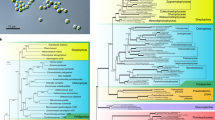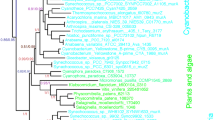Abstract
Transcriptomic sequencing together with bioinformatic analyses and an automated annotation process led us to identify novel phytochelatin synthase (PCS) genes from two extremophilic green algae (Chlamydomonas acidophila and Dunaliella acidophila). These genes are of intermediate length compared to known PCS genes from eukaryotes and PCS-like genes from prokaryotes. A detailed phylogenetic analysis gives new insight into the complicated evolutionary history of PCS genes and provides evidence for multiple horizontal gene transfer events from bacteria to eukaryotes within the gene family. A separate subgroup containing PCS-like genes within the PCS gene family is not supported since the PCS genes are monophyletic only when the PCS-like genes are included. The presence and functionality of the novel genes in the organisms were verified by genomic sequencing and qRT-PCR. Furthermore, the novel PCS gene in Chlamydomonas acidophila showed very strong induction by cadmium. Cloning and expression of the gene in Escherichia coli clearly improves its cadmium resistance. The gene in Dunaliella was not induced, most likely due to gene duplication.





Similar content being viewed by others
References
Jain CK (2004) Metal fractionation study on bed sediments of river Yamuna, India. Water Res 38:569–578
Rea PA, Vatamaniuk OK, Rigden DJ (2004) Weeds, worms, and more. Papain’s Long-Lost Cousin, Phytochelatin Synthase. Plant Physiol 136:2463–2474
Rausch T, Wachter A (2005) Sulfur metabolism: a versatile platform for launching defence operations. Trends Plant Sci 10:503–509
Grill E, Winnacker E-L, Zenk MH (1987) Phytochelatins, a class of heavy-metal-binding peptides from plants, are functionally analogous to metallothioneins. Proc Natl Acad Sci USA 84:439–443
Mishra S, Srivastava S, Tripathi RD, Govindarajan R, Kuriakose SV, Prasad MN (2006) Phytochelatin synthesis and response of antioxidants during cadmium stress in Bacopamonnieri L. Plant Physiol Biochem 44:25–3
Cobbett CS (2000) Phytochelatin biosynthesis and function in heavy-metal detoxification. Curr Opin Plant Biol 3:211–216
Clemens S, Kim EJ, Neumann D, Schroeder JI (1999) Tolerance to toxic metals by a gene family of phytochelatin synthases from plants and yeast. EMBO J 18:3325–3333
Vivares D, Arnoux P, Pignol D (2005) A papain-like enzyme at work: native and acylenzyme intermediate structures in phytochelatin synthesis. Proc Natl Acad Sci U S A 102:18848–18853
Rea PA (2012) Phytochelatin synthase: of a protease a peptide polymerase made. Physiol Plant 145:154–164
Ramos J, Clemente MR, Naya L et al (2007) Phytochelatin synthases of the model legume Lotus japonicus. A small multigene family with differential response to cadmium and alternatively spliced variants. Plant Physiol 143:1110–1118
Liu Z, Gu C, Chen F, Yang D, Wu K, Chen S, Jiang J, Zhang Z (2012) Heterologous expression of a Nelumbo nucifera phytochelatin synthase gene enhances cadmium tolerance in Arabidopsis thaliana. Appl Biochem Biotechnol 166:722–734
Shukla D, Kesari R, Mishra S et al (2012) Expression of phytochelatin synthase from aquatic macrophyte Ceratophyllum demersum L. enhances cadmium and arsenic accumulation in tobacco. Plant Cell Rep 31:1687–1699
Clemens S (2006) Evolution and function of phytochelatin synthases. J Plant Physiol 163:319–332
Clemens S, Peršoh D (2009) Multi-tasking phytochelatin synthases. Plant Sci 177:266–271
Nordstrom DK, Alpers CN (1999) Negative pH, efflorescent mineralogy and consequences from environmental restoration at the Iron Mountain Superfund site, California. Proc Natl Acad Sci U S A 96:3455–3462
Nixdorf B, Wollmann K, Deneke R (1998) Ecological potentials for planktonic development and food web interactions in extremely acidic mining lakes in Lusatia. In: Geller J, Klapper H, Salomons W (eds) Acidic mining lakes. Springer, New York, pp 147–167
Aguilera A, Manrubia SC, Gómez F, Rodriguez N, Amils R (2006) Eukaryotic community distribution and their relationship with the water physicochemical parameters in an extreme acidic environment, Río Tinto (SW, Spain). Appl Environ Microbiol 72:5325–5330
Dopson M, Baker-Austin C, Koppineedi PR, Bond P (2003) Growth in sulfidic mineral environments: metal resistance mechanisms in acidophilic micro-organisms. Microbiol 149:1959–1970
Dopson M, Ossandon FJ, Lövgren L, Holmes D (2014) Metal resistance or tolerance? Acidophiles confront high metal loads via both abiotic and biotic mechanisms. Front Microbiol 5:1–4
Olsson S, Puente-Sánchez F, Gómez-Rodriguez M, Aguilera A (2015) Transcriptional response to copper excess and identification of genes involved in heavy metal tolerance in the extremophilic microalga Chlamydomonas acidophila. Extremophiles 19:657–672
Puente-Sánchez F, Olsson S, Aguilera A (2016) Comparative transcriptomic analysis of the response of Dunaliella acidophila (Chlorophyta) to short-term Cadmium and chronic natural metal-rich water exposures. Microb Ecol. doi:10.1007/s00248-016-0824-7
Guanzon NG, Nakahara H, Yoshida Y (1994) Inhibitory effects of heavy metals on growth and photosynthesis of three freshwater microalgae. Fish Sci 60:379–384
Worms IA, Boltzman J, Garcia M, Slaveykova VI (2012) Cell-wall-dependent effect of carboxyl-CdSe/ZnS quantum dots on lead and copper availability to green microalgae. Environ Pollut 167:27–33
de Abreu FC, da Costa PN, Brondi AM et al (2014) Effects of cadmium and copper biosorption on Chlorella vulgaris. Bull Environ Contam Toxicol 93:405–9
Keller MD, Selvin RC, Claus W, Guillard RRL (1987) Media for the culture of oceanic ultraphytoplankton. J Phycol 23:633–638
Fei X, Eriksson M, Li Y, Deng X (2010) A Novel Negative Fe-Deficiency-Responsive Element and a TGGCA-Type-Like FeRE Control the Expression of FTR1 in Chlamydomonas reinhardtii. J Biomed Biotechnol 2010:790247
Müller K, Quandt D, Müller J, Neinhuis C (2005) PhyDE ® 0.995: Phylogenetic Data Editor, http://www.phyde.de
Díaz S, Amaro F, Rico D et al (2007) Tetrahymena metallothioneins fall into two discrete subfamilies. PLoS ONE 2, e291
Stover NA, Krieger CJ, Binkley G et al (2005) Tetrahymena Genome Database (TGD): a new genomic resource for Tetrahymena thermophila research. Nucleic Acids Res 34:D500–D503
Larinov A, Krause A, Miller W (2005) Standard curve based method for relative real time PCR data processing. BMC Bioinform 6:62
Mirete S, Mora-Ruiz MR, Lamprecht-Grandío M, de Figueras CG, Rosselló-Móra R, González-Pastor JE (2015) Salt resistance genes revealed by functional metagenomics from brines and moderate-salinity rhizosphere within a hypersaline environment. Front Microbiol 6:1121
Artimo P, Jonnalagedda M, Arnold K et al (2012) ExPASy: SIB bioinformatics resource portal. Nucleic Acids Res 40:W597–W603
Finn RD, Clements J, Eddy SR (2011) HMMER web server: interactive sequence similarity searching. Nucleic Acids Res 39:W29–W37
Käll L, Krogh A, Sonnhammer ELL (2007) Advantages of combined transmembrane topology and signal peptide prediction—the Phobius web server. Nucl Acids Res 35:W429–32
Altschul SF, Madden TL, Schaffer AA, Zhang J, Zhang Z, Miller W, Lipman DJ (1997) Gapped BLAST and PSI-BLAST: z new generation of protein database search programs. Nucl Acids Res 25:3389–3402
Katoh K, Misawa K, Kuma K, Miyata T (2002) MAFFT: a novel method for rapid multiple sequence alignment based on fast Fourier transform. Nucl Acids Res 30:3059–3066
Ronquist F, Huelsenbeck JP (2003) MRBAYES 3: Bayesian phylogenetic inference under mixed models. Bioinformatics 19:1572–1574
Huelsenbeck JP, Ronquist F, Nielsen R, Bollback JP (2001) Bayesian inference of phylogeny and its impact on evolutionary biology. Science 294:2310–2314
Stöver BC, Müller KF (2010) TreeGraph 2: Combining and visualizing evidence from different phylogenetic analyses. BMC Bioinform 11:7
Di Giammartino DC, Nishida K, Manley JL (2011) Mechanisms and consequences of alternative polyadenylation. Mol Cell 43:853–866
Shen Y, Liu Y, Liu L, Liang C, Li QQ (2008) Unique features of nuclear mRNA poly(A) signals and alternative polyadenylation in Chlamydomonas reinhardtii. Genetics 179:167–176
Oremland RS, Saltkov CW, Wolfe-Simon F, Stolz JF (2009) Arsenic in the evolution of earth and extraterrestrial ecosystems. Geomicrobiol J 26:522–536
Dani SU (2010) Gold, coal and oil. Med Hypotheses 74:534–541
Mendoza-Cózatl DG, Jobe TO, Hauser F, Schroeder JI (2011) Long-distance transport, vacuolar sequestration, tolerance, and transcriptional responses induced by cadmium and arsenic. Curr Opin Plant Biol 14:554–562
Rosen BP (1999) Families of arsenic transporters. Trends Microbiol 7:207–212
Petraglia A, De Benedicti M, Degola F et al (2014) The capability to synthesize phytochelatins and the presence of constitutive and functional phytochelatin synthases are ancestral (plesiomorphic) characters for basal land plants. J Exp Bot 65:1153–1163
Keeling PJ, Palmer JD (2008) Horizontal gene transfer in eukaryotic evolution. Nat Rev Genet 9:605–618
Richards TA, Soanes DM, Foster PG, Leonard G, Thornton CR, Tallbot NJ (2009) Phylogenomic analysis demonstrates a pattern of rare and ancient horizontal gene transfer between plants and fungi. Plant Cell 21:1897–1911
Blanc G, Agarkova I, Grimwood J, Kuo A, Brueggeman A, Dunigan DD et al (2012) The genome of the polar eukaryotic microalga Coccomyxa subellipsoidea reveals traits of cold adaptation. Genome Biol 13:R39
Schönknecht G, Chen WH, Ternes CM et al (2013) Gene transfer from bacteria and archaea facilitated evolution of an extremophilic eukaryote. Science 339:1207–10
Acknowledgments
This work was supported by the Spanish Ministry of Economy and Competitivity (MINECO) under Grant CGL-2011-22540 to AA. We acknowledge CSC-IT Center for Science Ltd. (Finland) for the allocation of computational resources. Dr. Salvador Mirete (Centro de Astrobiología CSIC-INTA) is acknowledged for assistance with the growth curves for the analysis of cadmium resistance in E. coli. FP-S was supported by a JAE-pre fellowship from the Spanish Consejo Superior de Investigaciones Científicas (CSIC).
Author information
Authors and Affiliations
Corresponding author
Electronic supplementary material
Below is the link to the electronic supplementary material.
Online Resource 1
ART II medium used for the cultivation of Dunaliella acidophila strain RT5. The volume was brought to 1 l with distilled water and the pH adjusted with 0.1 N H2SO4. (PDF 256 kb)
Online Resource 2
Quantitative reverse transcription PCR standard-curve parameters for target gene (novel phytochelatin synthase in Chlamydomonas acidophila CaPCS2) and the expression control (housekeeping) genes 18S rRNA and actin. E = amplification efficiency, S = slope, R2 = correlation coefficient. (PDF 393 kb)
Online Resource 3
Flow chart on the process from culture to extraction to analyses for the sequences used in the current study. (PDF 359 kb)
Online Resource 4
Results for BLASTx search using the open reading frame of transcripts coding for CaPCS2 (isotig12422) and DaPCS (comp2951_c3_seq1 and comp2951_c3_seq2) as query. (TXT 110 kb)
Online Resource 5
Introns in the predicted PCS genes from C. acidophila and D. acidophila. There are three spliceosomal introns in CaPCS2, four in CaPCS1 and three in DaPCS1. The introns are either the most common GT-AG splice site or variations of it. (PDF 19 kb)
Online Resource 6
Different contigs of component comp17619_c0 coding for the CaPCS1 gene in Chlamydomonas acidophila. (TXT 11 kb)
Online Resource 7
Different contigs of component comp11852_c0 coding for the CaPCS2 gene in Chlamydomonas acidophila. (TXT 18 kb)
Online Resource 8
PCR products amplified in Dunaliella acidophila strain RT5 using gradient annealing run on 1 % agarose gel (1X TBE). The gel electrophoresis shows amplification of products sized 1198 bp and 542 bp and several non-specific amplification products. The intensity of the non-specific bands depends on the used annealing temperature and PCR program. Wells 1: Ladder 1 kb (Promega Corporation), marker sizes from 250 kb to 10,000 kb, well 2: annealing 52-55 °C. Well 3: annealing 55-60 °C. (PDF 51 kb)
Online Resource 9
Phylogram based on the novel phytochelatin synthase genes and the most similar genes obtained with a BLASTx search against NCBI’s databases. The tree represents the majority consensus of trees sampled after stationarity in the Bayesian analysis. PP values from the Bayesian inference > 0.50 are indicated above each branch. The amino acid alignment was 383 aa long. (PDF 871 kb)
Rights and permissions
About this article
Cite this article
Olsson, S., Penacho, V., Puente-Sánchez, F. et al. Horizontal Gene Transfer of Phytochelatin Synthases from Bacteria to Extremophilic Green Algae. Microb Ecol 73, 50–60 (2017). https://doi.org/10.1007/s00248-016-0848-z
Received:
Accepted:
Published:
Issue Date:
DOI: https://doi.org/10.1007/s00248-016-0848-z




